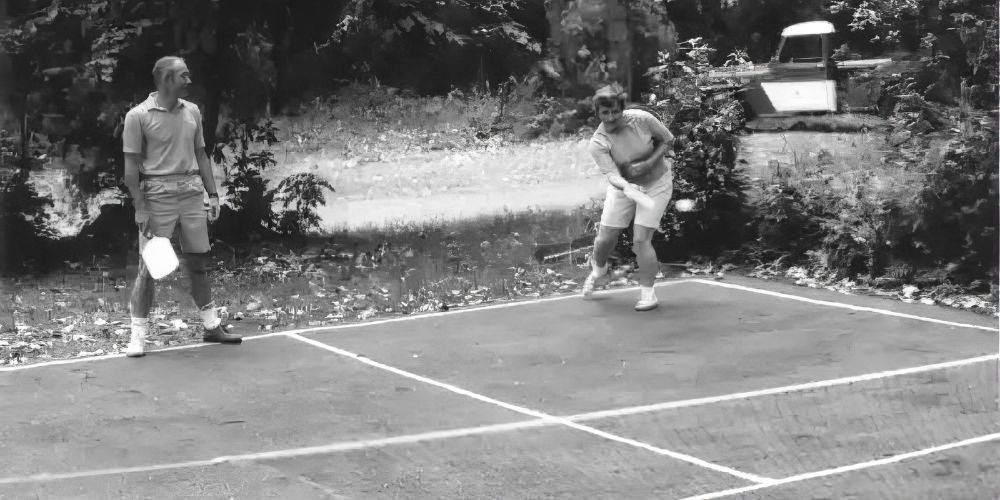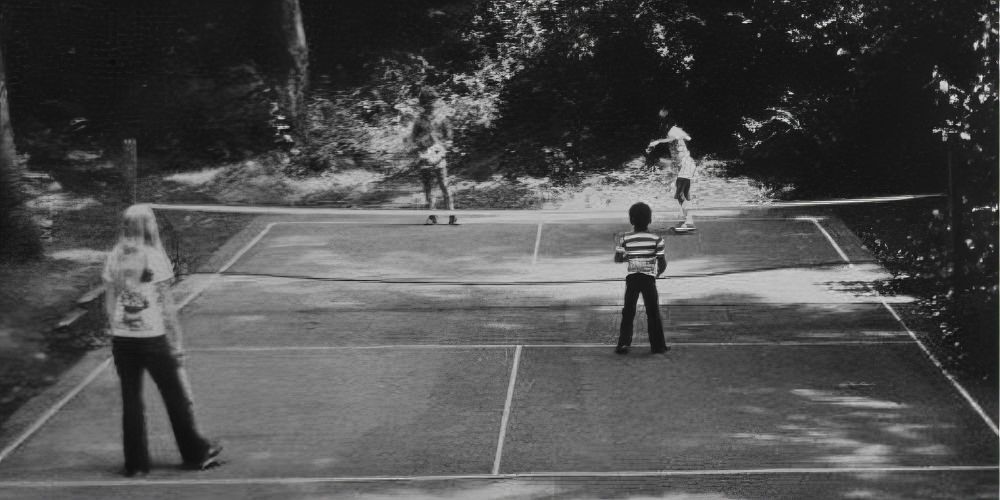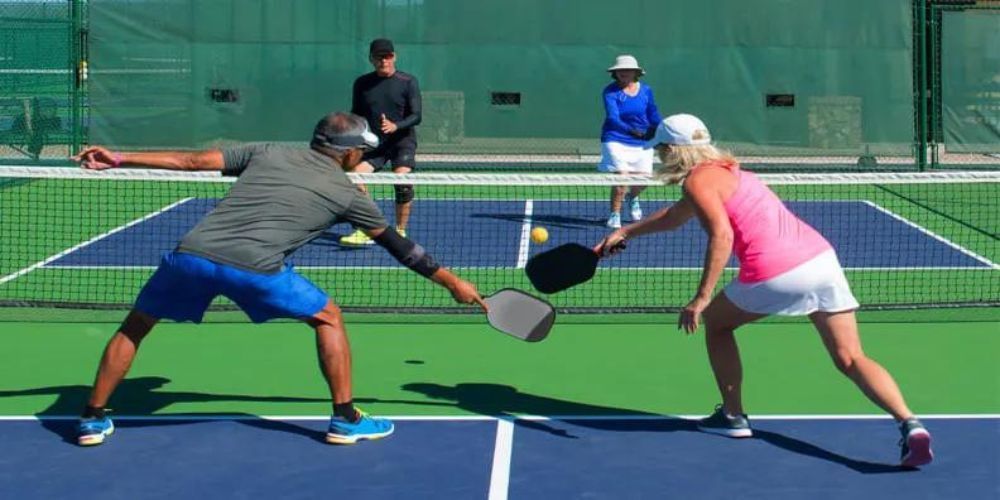Exploring the Evolution and Popularity of Pickleball: A Historical Perspective
July 27, 2024
In the summer of 1965, on Bainbridge Island, Washington, three fathers—Joel Pritchard, Bill Bell, and Barney McCallum—were faced with bored children and an empty badminton court. Using a perforated plastic ball and handmade paddles, they invented what would become one of today's fastest-growing sports: pickleball. Contrary to what many believe, the game's name was inspired not by a pet dog but by the "pickle boat" term used in crew races.
Over decades, pickleball transformed from casual backyard entertainment into a standardized sport with national tournaments and associations like the
U.S.A. Pickleball Association (USAPA). Key milestones include establishing basic rules to accommodate various skill levels and organizing the first USA Pickleball National Championships in 2009. These achievements reflect both dedication and strategic planning—elements crucial for any sport's rise to prominence. Understanding these events helps uncover why pickleball has resonated with so many people today.
The history of pickleball dates back to the summer of 1965, when Joel Pritchard, Bill Bell, and Barney McCallum invented the game on Bainbridge Island, Washington. It began as a family activity but quickly gained popularity, leading to the establishment of rules and equipment specific to the sport. Over time, it expanded from a backyard pastime to a widely recognized and beloved sport played by people of all ages around the world.

The Origins of Pickleball
The birthplace of this beloved sport was none other than Bainbridge Island, Washington, back in the summer of 1965. It all began when Joel Pritchard, a congressman and former lieutenant governor of Washington state, found himself in quite the conundrum. His children were eager for something fun to do, and on a hot summer day, their badminton equipment was nowhere to be found.
Unwilling to let his kids' enthusiasm go to waste, Pritchard decided to create a game by adapting existing sports. With a handy badminton court, a perforated plastic ball that he acquired from a nearby toy store, and some handmade paddles crafted from plywood, the first-ever game of Pickleball came to life. This ingenious improvisation eventually evolved into the stimulating and fast-paced game that is beloved by people worldwide today.
Contrary to popular belief, the game’s name has nothing to do with a family pet named Pickles. Instead, it stems from an amusing anecdote related to rowing—a "pickle boat" refers to the last remaining boat on which teams that had not secured victories would compete among each other. In a similar vein, Pickleball was initially referred to as "Pickle Boat" in local races. Hence, it is clear that the game's nomenclature is an ode to the local sporting vernacular rather than honoring a furry companion.
To put it simply, just as a fine wine carries with it the essence of the vineyard where it was grown, the identity and backstory of Pickleball are deeply intertwined with the unique circumstances and anecdotes from Bainbridge Island.
The story behind the creation of Pickleball showcases resourcefulness, innovation, and a keen spirit for recreation. But this distinctive origin story is just the tip of the iceberg when it comes to understanding the evolution and rise of this dynamic and engaging sport.
The narrative behind Pickleball's inception paints a vivid picture of creativity and determination. However, there are further key moments that have shaped the history and trajectory of this captivating pastime.
Key Milestones in Pickleball History
Between 1965 and 1970, the game swiftly evolved from a casual backyard activity to an organized sport. The first official game was played using improvised equipment, laying the groundwork for future advancements. This period also witnessed the establishment of basic rules to accommodate both adults and children, setting the stage for the game's adaptability and robust growth.
Moving forward to 1984, a pivotal moment emerged with the establishment of the USA Pickleball Association (USAPA). The birth of this association marked a significant step forward as it aimed to standardize rules and promote the sport across the country. By unifying regulations and forming a cohesive entity to advocate for its growth, pickleball gained increased legitimacy and structure.
In 2009, an event that greatly influenced the sport's popularity transpired—the introduction of the first USA Pickleball National Championships. This tournament brought together top players from across the nation, drawing attention and recognition to pickleball on a larger scale. The prominent exposure from this event sparked heightened interest and participation, contributing to the sport's widespread growth.
These milestones serve as crucial touchpoints in pickleball's journey, solidifying its roots, standardizing its structure, and boosting its public profile. Each event played a pivotal role in shaping pickleball into the flourishing and beloved sport it is today.
With a firm understanding of pickleball's historical evolution, we now pivot our focus to explore how equipment advancements have shaped the game into what it is today.

Evolution of Pickleball Equipment
In the early days of pickleball, the first paddles players used were quite simple in design. They resembled ping-pong paddles and were made of wood. Alongside these paddles, players utilized a standard wiffle ball, similar to those used in backyard games, as the primary playing tool.
As the game gained popularity and players sought equipment to enhance their performance, innovation led to the introduction of composite materials in paddle construction. Lightweight aerospace composite materials like fiberglass and graphite started to be utilized, offering improved durability and overall performance compared to the traditional wooden paddles. This shift in material dramatically enhanced play as it allowed for better control and maneuverability, fundamentally altering the nature of the game.
Moreover, as the game continued to grow in popularity and was played in a variety of settings, modern pickleball balls underwent substantial changes. The original plastic wiffle ball was gradually replaced with specialized polymer balls that were designed for both indoor and outdoor play. These modern pickleball balls feature a more durable construction which contributes to their consistency in bounce and overall playability.
The introduction of composite materials not only transformed the game by providing players with more durable and high-performing equipment but also significantly contributed to the widespread appeal of pickleball.
The continuous evolution of pickleball equipment underscores the commitment to enhancing player experience while maintaining the integrity and spirit of the game. This dedication to improvement has been pivotal in driving the sustained popularity and growth of pickleball as a sport enjoyed by people of all ages and skill levels.
As we marvel at how innovations have sculpted pickleball into its present form, let's now direct our attention to the foundation upon which this thrilling game is played – the structure and layout of pickleball courts.

Structure and Layout of Pickleball Courts
The standard dimensions of a pickleball court play a vital role in defining the game's dynamics. Similar in size to a doubles badminton court, a pickleball court measures 20 feet by 44 feet. This compact playing area provides an optimal space for players to engage in quick and dynamic rallies. The specific layout of a pickleball court also enhances the strategic elements that set the game apart.
One key feature of a pickleball court is the non-volley zone, often referred to as the "kitchen." Extending 7 feet from the net on both sides, this designated zone restricts players from executing volleys within its boundaries. The purpose of this zone is to encourage more strategic shot placement and minimize reliance on reflex volleys, fostering a deeper level of tactical play. By requiring players to step inside the non-volley zone to hit groundstrokes or low shots, it adds an extra layer of skill and precision to the game.
In addition to the dimensions and specific areas, the surface and net specifications directly impact gameplay. Pickleball courts can be constructed from various surfaces including concrete or asphalt, each with its own characteristics that influence ball bounce and player movement. The net height is another critical component, measuring 36 inches at the sidelines and 34 inches at the center. This subtle variation in net height accommodates the natural slope of the court, ensuring uniformity across the entire playing area.
Understanding these structural elements not only enhances one's appreciation for the nuances of pickleball but also provides valuable insights into the strategic elements underpinning the sport. The combination of precise dimensions, specific areas, and surface specifications creates an environment where skillful shot placement and strategic maneuvering take precedence, reinforcing pickleball's reputation as a highly engaging and dynamic game.
With a solid understanding of the foundational aspects of pickleball courts, let's now turn our attention to the regulations that govern gameplay in this fast-paced and exciting sport.
Notable Rules and Regulations
Playing any sport requires an understanding of its rules and ensuring compliance. Pickleball is no different, with its unique set of regulations that players must adhere to.
Service Rules
When serving in pickleball, the player must follow specific regulations. The server must stand behind the baseline and hit the ball underhand. This rule gives pickleball its distinct style compared to other racket sports like tennis or badminton. Additionally, the serve must land in the opposite diagonal court, beyond the non-volley zone, adding a layer of precision and strategy to the game.
Imagine it as a careful game of chess where each move counts. The service rules in pickleball prompt players to be calculated in their approach, guiding them to focus on not just power but also finesse.
Game Scoring
Game scoring, a fundamental aspect of any sport that determines its flow and intensity, is also crucial in pickleball. Games are typically played to 11 points, with a required two-point lead for victory. However, in competitive matches, this can be extended to 15 or even 21 points. This flexibility allows for different levels of play, accommodating both casual enthusiasts and serious competitors.
As you progress in your pickleball journey, don't be surprised if you find yourself adjusting to various scoring formats based on the level of competition and the nature of the games.
Double Bounce Rule
One distinctive feature that sets pickleball apart is the double bounce rule. Both the serving and receiving teams must let the ball bounce once before volleys are allowed, enhancing rally quality and game depth. This rule adds a tactical element to the game, encouraging players to strategize around positioning and timing rather than relying solely on power shots.
The beauty of the double bounce rule lies in its ability to foster engaging exchanges at the net while maintaining fairness and sportsmanship throughout the match.
Understanding these rules not only enhances your gameplay but also contributes to a vibrant and welcoming pickleball community where everyone can enjoy this exciting sport together.
Equipped with a deeper understanding of pickleball's rules and regulations, we're ready to explore how these elements have contributed to the rise in popularity and cultural impact of this dynamic sport.
Rise in Popularity and Cultural Impact
Just a few decades ago, the rackets-and-net game of pickleball was only known to a small circle of friends and family. But today, things are quite different. Pickleball has become a cultural phenomenon that has not only burst out of its grassroots bubble but has also been embraced by the mainstream sports community.
The rise in popularity of pickleball is not just due to happenstance; it's rooted in various factors such as increased media coverage and the sport catching the eye of some prominent celebrities. Much like any modern trend that balloons into fame, pickleball has used its growing recognition to draw attention from the public, convincing many that it’s a sport worth playing.
The appeal of pickleball has not been restricted to any particular age group or demographic, which is one reason for its inclusive play. The surge in pick-up games and organized leagues, combined with its adaptability for people of all ages and abilities, have made it accessible and engaging—a trait that has not been lost on anyone who's had the chance to experience the sport firsthand.
Moreover, the influence of key figures endorsing the sport has also played a part in propelling pickleball into widespread acknowledgment. When individuals in the public eye speak favorably about an activity – especially when these individuals have a significant social following –it tends to pique curiosity and inspire interest across various circles.
According to USA Pickleball, there are now over 4.2 million players in the U.S., signifying a remarkable growth rate of 21.3% from 2020 to 2023. These statistics underline the rapid adoption of this unassuming racquet sport as one that is accessible to people of all ages and skill levels. Indeed, this growth illustrates its undeniable embracement as a popular sport enjoyed nationwide.
From its early days as a backyard activity to newfound recognition as a legitimate sporting event, pickleball's ascendancy parallels the evolving recreational landscape and its transformative cultural impact. Its expanding allure speaks volumes about its universal appeal and underscores its significance in today's sporting world.
The ascendancy of pickleball serves as a testament to the transformative power of sports in culturally uniting people and transcending generational boundaries. As it continues to gain traction, its narrative becomes increasingly intertwined with broader societal shifts and contemporary leisure pursuits.
How did pickleball originate and who invented it?
Pickleball was invented in 1965 on Bainbridge Island, Washington, by three dads – Joel Pritchard, Bill Bell, and Barney McCallum. Looking for a way to entertain their bored children during the summer, they created a game using a perforated plastic ball, wooden paddles, and a badminton net. The game was initially played on a badminton court, but as it evolved, the net was lowered to 36 inches at the ends and 34 inches in the middle, and new rules were established to accommodate the ball’s bounce and the play style.
The name “pickleball” has two popular origin stories. One claims the game was named after the Pritchards’ dog, Pickles, who would chase the ball and run off with it. The other suggests that Joel Pritchard’s wife, Joan, named it after the pickle boat in crew racing, referring to a boat made up of leftover oarsmen from other boats, much like pickleball was created from borrowed equipment from other sports. Regardless of its naming origin, pickleball quickly gained popularity for its simple rules and accessibility for players of all ages and skill levels.
Why has pickleball become so popular in recent years?
Pickleball’s surge in popularity can be attributed to several factors:
Accessibility: The game is easy to learn and can be played by people of all ages and skill levels. Its rules are simple, and it doesn’t require extensive equipment or a large playing area, making it accessible to many people.
Health Benefits: Pickleball offers a great workout that improves cardiovascular health, balance, and agility. It’s less strenuous on the joints compared to sports like tennis, making it appealing to older adults and those with physical limitations.
Social Interaction: Pickleball is inherently social, often played in doubles, which fosters interaction and camaraderie among players. Community centers, parks, and recreational facilities frequently host pickleball games and tournaments, creating social opportunities.
Adaptability: The sport can be played indoors or outdoors, in singles or doubles, making it versatile for different environments and group sizes. Many tennis courts have been converted to accommodate pickleball, further increasing its availability.
Promotion and Media: Increased media coverage, along with endorsements from professional athletes and celebrities, has brought more attention to the sport. Social media platforms and online communities have also played a significant role in spreading the word about pickleball.
The combination of these factors has led to a rapid growth in pickleball participation worldwide, with more people discovering and enjoying the game each year.
What are the basic rules and equipment needed for pickleball?
Pickleball combines elements of tennis, badminton, and ping-pong, and is played on a court similar to a badminton court with a few modifications. Here are the basic rules and equipment needed:
Basic Rules:
Serve: The game begins with an underhand serve, made diagonally to the opponent’s service court. The serve must be hit below the waist and land beyond the non-volley zone (also known as the kitchen).
Scoring: Only the serving team can score points. Games are typically played to 11 points, with a win by 2 points. Points are scored when the opposing team fails to return the ball, hits it out of bounds, or commits a fault.
Double Bounce Rule: After the serve, each team must let the ball bounce once on their side before volleying it (hitting it out of the air). This rule promotes longer rallies and minimizes the advantage of serving.
Non-Volley Zone: Players cannot volley the ball while standing in the non-volley zone, which is a 7-foot area on both sides of the net. This rule prevents players from dominating the net area with aggressive volleys.
Faults: A fault occurs when the ball is hit out of bounds, into the net, or a player steps into the non-volley zone and volleys the ball.
Equipment Needed:
Paddle: Pickleball paddles are typically made of lightweight materials such as wood, composite, or graphite. They are larger than ping-pong paddles but smaller than tennis racquets.
Ball: The ball used in pickleball is a perforated plastic ball, similar to a wiffle ball. It is designed to be lightweight and have a lower bounce compared to tennis balls.
Court: A pickleball court is 20 feet wide and 44 feet long, with a net height of 36 inches at the ends and 34 inches in the middle. The court includes a non-volley zone, service courts, and baselines.
Net: The net used in pickleball is 36 inches high at the ends and 34 inches high in the middle. It is slightly lower than a tennis net to accommodate the different dynamics of the game.
Understanding these basic rules and equipment will help new players get started with pickleball, ensuring they can enjoy the game and improve their skills over time.
Check out the latest guides on pickleball gear
Author: William Flaiz










